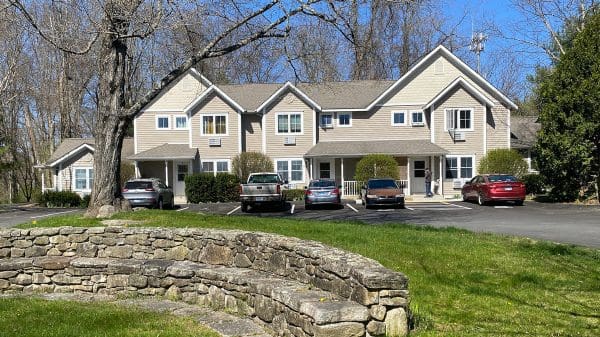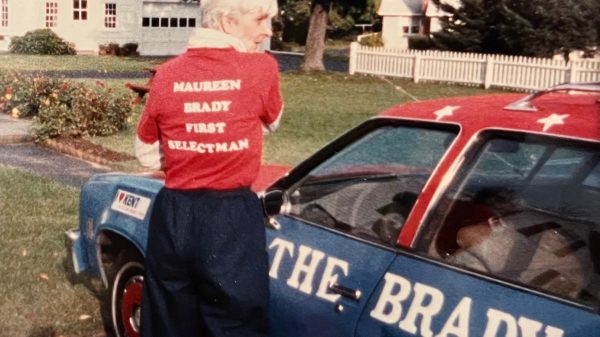KENT—On Sept. 13 a monumental, 58-foot-long memorial to the soldiers who fought and died in World War I will be dedicated in Pershing Park in Washington, D.C.

Few in town might know that the sculptor behind this magnificent bronze relief, titled “A Soldier’s Journey,” is Kent resident Sabin Howard. Howard will describe its creation at the Kent Community House, 93 North Main St., Saturday, July 6, at 7 p.m. in a program hosted by the Kent American Legion, Post 153, and the Kent Memorial Library.
The program, co-sponsored by the Roger Sherman Chapter of the DAR; Kent Art Association, and the Kent Historical Society, is free and open to the public but registration is requested.
The September installation marks the end of a nine-year odyssey for the sculptor. Like Odysseus, he had to overcome trials along the way—from conceptual disputes to a Covid lock-down and finding models and sculptors who fit the standards for his art.
The story began in 2015 when Howard and Joe Weishaar, his architectural design partner, entered the Centennial Commission competition to select a design for the memorial. Their dramatic design created was selected, but Howard soon ran into the politics surrounding public art and the design of Pershing Park.
Centennial Commission Chairman Edwin Fountain was clear about what he wanted. “The Centennial Commission asked specifically for a sculpture like the sculpture in front of the Grant Memorial,” Howard said. “That is so dramatic, you can almost see the sweat on the coats of the horses. They wanted me to make it active and visceral and dramatic.”

“But any real estate in Washington, D.C. is hard-fought over,” he continued. “The Commission of Fine Arts, which regulate art in the city, tried to take over and dictate where it would go. And they did not want a figurative work. Technology, modernism and politics have made sure that traditional ways of working aren’t in the modern art narrative, and they weren’t looking for my kind of sculpture. That was the worst of the nine years, but we got through it.”
Howard, who grew up both in America and Italy, said he knew nothing about modern art when he first went to college. “I grew up in Italy, surrounded by the work of Michelangelo, Leonardo and Raphael and my work is completely derivative from the Renaissance. I make no apologies for that—I believe that tradition is not the worship of ashes, but the preservation of fire. I am fighting a huge battle against modern art with this project. My work is very understandable to the people of this country.”
But it was a struggle to get approval. “I had to hold onto my vision and not lose my sense of where I had to go. In many ways, I was failing because so many people were telling me what to do. It was very stressful. Then, I had a moment in March or April 2016, when I had a sense of ‘Do what you know.’ I did 25 iterations for the Commission of Fine Arts and each one got sharper and sharper and sharper, becoming a very precise story.”
He finally received approval in May 2017.
He discovered that his theme paralleled Joseph Campbell’s “Monomyth,” sometimes referred to as the “Hero’s Journey,” a theme found in all cultures and every historical era. On the “Hero’s Journey,” the individual receives a call, goes through an ordeal, is transformed and returns home forever changed. “That is what this is about,” he said. “It is really an allegory for the United States.”

His efforts went international in 2017 when he flew to New Zealand where he began work with WETA Workshops, known for its work in “Lord of the Rings” and “Avatar.” It has advanced photogrammetry systems that made a virtual 3-D scan of Howard’s models. These were transformed into life casts that were milled as a very precise armatures for the sculptured figures.
In 2019, the Centennial Commission, which financed the multi-million project asked essential questions: How much would it cost, how long would it take to produce and where would it be produced. Howard found himself in an unusual position.
“It was not just me sculpting anymore,” he said. “Before I ran a mom-and-pop business making individual figures. Now, all of a sudden, I have employees, all the logistics of a full-time-plus position. You kind of have to have abilities external to sculpting. I had to manage timelines, have communications skills and administrative tools.”
He turned to his wife, writer Traci Slatton, as his project manager, while he searched for a foundry that met his demanding specifications. “I told the Centennial Commission, ‘I can’t tell you how much it will cost until I do due diligence.’ I toured 25 foundries in the U.S. and couldn’t find one.”
He finally settled on a foundry in the Cotswolds in England. “That foundry has a tremendous amount of craftsmanship and a 40-year history with esthetics.”
With models made, a foundry located, and a 50-by-100-foot studio constructed in New Jersey, he was ready to sculpt in 2019. “It felt odd because I had been drawing and doing little models for four years,” he said, “but I was more than okay going back to work. After about two hours, it all kicks in again.”
“I was handed a project that was very valuable on many levels,” he said. “I was the caretaker of the project. It wasn’t about me; it was about 22 million people who were killed in World War I.”
—Sabin Howard, sculptor
For the next four years, he and a team of sculptors worked on the 38 heroic-scale figures. He fired several sculptors because they didn’t learn his unique way of sculpting, which he described as a “highly focused, descriptive way of translating life models into sculptures.”
“I do a lot of diagramming, a lot of drawing lines on the clay—it becomes a roadmap,” he said. The sculptures, which take 600 to 800 hours to produce, are precisely accurate. “You have got to be in it; completely focused,” he said. “The sculptors couldn’t hang in there. Only Charlie Mostow stayed with me all the way.”
Then he started firing models. “I was handed a project that was very valuable on many levels,” he said. “I was the caretaker of the project. It wasn’t about me; it was about 22 million people who were killed in World War I. I fired models who did not bring a sense of being in service of something way greater than themselves.”
He turned next to veterans for models because “their histories and experiences are in their bones. I chose ones who are still fit, who carry strong skeleton structure in their faces, in their cheekbones and brows. You can’t use actors—actors don’t know war, so they look like college boys.”
Kent security consultant Chris Rehnberg, an Army ranger and veteran, was the model for the head of the shellshocked soldier.
During Covid, Howard had to learn some of the stoic acceptance of soldiers who went “over the top” onto World War I battlefields. The UK foundry was supposed to come to New Jersey to make models for casting, but the world was in lock-down. “So, we had to come up with something creative,” Howard said, describing how original molds were crated and shipped to the Cotswolds.

“It’s unheard of to ship original molds,” he said. “If you think about it, you will lose your mind. I had to turn it over to the universe. But it worked. There was only one little problem that I fixed in 40 minutes.”
It worked so well the same method was used throughout production.
The work is now virtually complete. Howard is currently in England doing the patina on the final figures. The project will be shipped to Washington at the end of June and will be dedicated Sept. 13.
Howard said the project has forever changed his art. “To believe in something larger than yourself is so empowering,” he said.


























